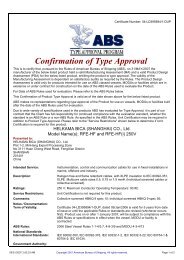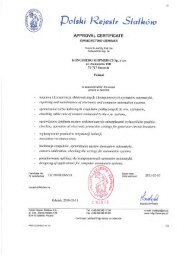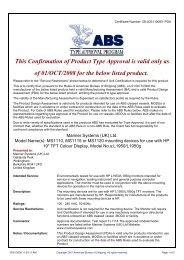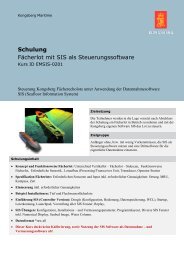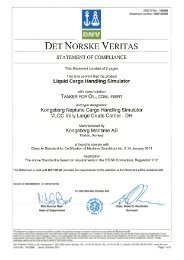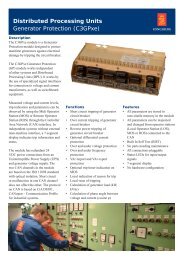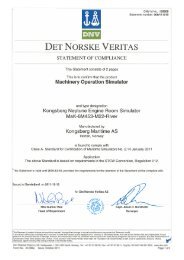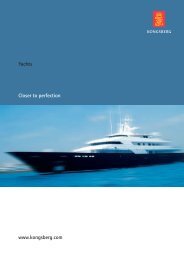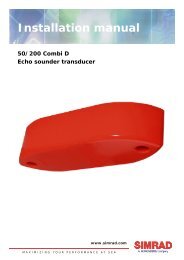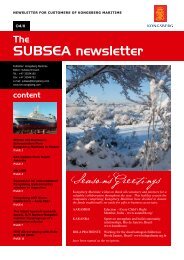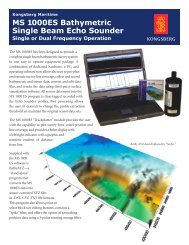March 2006 - Kongsberg Maritime
March 2006 - Kongsberg Maritime
March 2006 - Kongsberg Maritime
You also want an ePaper? Increase the reach of your titles
YUMPU automatically turns print PDFs into web optimized ePapers that Google loves.
THE SUBSEA NEWSLETTER PAGE 3<br />
MARCH <strong>2006</strong><br />
A seminar on seafloor classification<br />
December 1 and 2 2005, <strong>Kongsberg</strong><br />
<strong>Maritime</strong> invited some of the users<br />
of Neptune (later named Neptune-B),<br />
Triton (later named Neptune-C) and<br />
Poseidon (later named Neptune-S) to<br />
Horten for a seminar on seafloor<br />
classification.<br />
The seminar gathered participants from<br />
<strong>Kongsberg</strong> <strong>Maritime</strong>, several customers<br />
using our products, scientists and developers<br />
from research institutions.<br />
The first thing to discuss was how to<br />
use multibeam echosounders as a tool<br />
for seafloor classification. Kjell Nilsen<br />
from <strong>Kongsberg</strong> <strong>Maritime</strong> gave an<br />
overview of the acoustic principles of<br />
multibeam echosounders and the ongoing<br />
development in Horten. Terje<br />
Pedersen (KM) presented the state<br />
of Neptune-B, -C and -S and the road<br />
ahead for the product was discussed.<br />
The new classification tool for Kongeberg<br />
single beam echosounders was demonstrated<br />
by T. T. Lied (KM). This tool,<br />
SeaBec, can take advantage of serveral<br />
frequencies to classify the seafloor. The<br />
results are available immediately in<br />
the geographical display and there are<br />
several options to control the operation<br />
of SeaBec.<br />
The seminar also contained papers from<br />
the participants. Professor J. M. Hovem<br />
presented a paper on how to use scattering<br />
theory in seafloor classification,<br />
M. A. Larsen presented his method for<br />
seafloor classification, R. Riethmuller<br />
presented results from seafloor classification<br />
using EM 3002 and ways to<br />
improve the system. M. Roche and K.<br />
Degrendele presented results from using<br />
Neptune-C and suggested tools to<br />
help the users make better use of the<br />
output from Neptune-C. T. Thorsnes<br />
presented a paper on how to use seafloor<br />
classification in the MAREANO<br />
project and needs for improvements in<br />
hardware and software. D. Simons and<br />
T. Driesenaar presented a seafloor classification<br />
system developed by TNO.<br />
Valuable contacts were made during<br />
the following discussions. The users of<br />
Neptune have over the years gathered<br />
vast experience in the use of seafloor<br />
classification, and the joint cooperation<br />
between the users, and between the<br />
users and scientists, will help the<br />
development of seafloor classification<br />
tools in the future.<br />
As a result of this seminar, new<br />
versions of Neptune-B, -C and -S are<br />
made available that we hope will help<br />
the users to make better use of the<br />
classification done in Neptune-C.<br />
Pipe-surveys in the North Sea<br />
Over the past year, the EM 3002 has<br />
been run on several pipe-surveys in<br />
the North Sea, by Stolt Offshore, now<br />
Acergy.<br />
The performance of the system has<br />
been documented and the EM 3002<br />
has been verified to be an important<br />
tool for inspecting gas and oil-pipes.<br />
The system has also been tested<br />
by Geoconsult on a new coated 8”<br />
pipe with good results. The system<br />
was tracking and displaying the<br />
pipe without any problems when the<br />
pipe was on support legs, and on the<br />
seabed without support legs.




